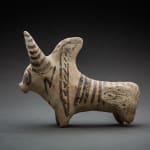Indus Valley Painted Terracotta Zebu Bull, 2600 BCE - 1900 BCE
Terracotta
height 8.9 cm
height 3 1/2 in
height 3 1/2 in
LO.1021
Further images
Terracotta figurines such as these ones have been unearthed also at Mohenjo-daro and Harappa, suggesting a commonality of style and purpose throughout the Indus Valley during the mature Harappan period...
Terracotta figurines such as these ones have been unearthed also at Mohenjo-daro and Harappa, suggesting a commonality of style and purpose throughout the Indus Valley during the mature Harappan period (ca. 2600-2450 BCE). Like many figurines datable to this period, the front and back legs are joined together. In one excavated example from Chanu-daro a hole was poked in the belly, indicating that it would have been attached to a stick for use as a puppet or a small standard of the kind carried in the processions depicted on some seals. In others, the hole was indeed placed on the back of the animal, thus suggesting an alternative function, perhaps linked to music.
For a comparable example see: J.Aruz ed, Art of the Ancient Cities, 2003: no.276, p.390. J.Kenoyer, Ancient Cities of the Indus Valley Civilization, 1998.
For a comparable example see: J.Aruz ed, Art of the Ancient Cities, 2003: no.276, p.390. J.Kenoyer, Ancient Cities of the Indus Valley Civilization, 1998.







